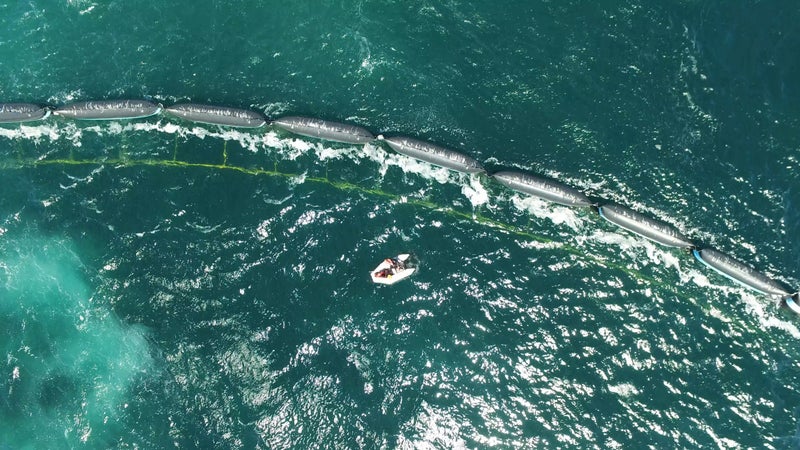Ten miles from the Dutch coast, near the top of a concrete high-rise in downtown Delft, is a palatial glass-walled office better suited to Silicon Valley than a 13th-century city. The building is home to the , a foundation created in 2013 that is hoping to deploy a giant 62-mile-wide filtration device in the Pacific Ocean, the initial step in an effort to rid the seas of plastic. When I visited the Netherlands last June for the launch of a scaled-down prototype, I found the CEO, 22-year-old , slumped in a cubicle. His shaggy hair gave him the look of either a boy-band star or an eccentric genius, depending on your opinion of him—and these days there are a few.
Slat is a new breed of environmentalist: young, crowdfunded, and tired of waiting around for government solutions. Still, he’s less a traditional ocean conservationist than a natural engineer. When he was 12, he set a Guinness World Record for the most water rockets launched simultaneously: 213.
“The way you advance a technological society is to try things—to be controversial and contrarian in your thinking.”
Slat’s inner environmentalist didn’t come alive until he was 16, when he began scuba diving on a trip to Greece. Expecting to see an array of sea creatures, he instead saw a slew of plastic trash. The experience was life changing. Slat, who would soon drop out of Delft University of Technology to focus on the issue full-time, remembers thinking, This plastic problem, I want to know more about it.
The news was grim. About nine million tons of plastic waste makes its way into the oceans each year—by 2050, plastic will outweigh fish. Making matters worse, much of the debris has been broken down by wind, waves, and sun into tiny microplastics, which are extremely difficult to remove.
As Slat’s obsession grew, he gravitated to the infamous Great Pacific Garbage Patch, a vast area between Hawaii and the North American continent, where it has been estimated that 170,000 tons of plastic rubbish swirl in the currents. He contacted marine engineers, scientists, and experts to talk about cleaning up the Garbage Patch. Everyone told him the problem was unsolvable. Dozens of other entrepreneurs were also searching for a solution, to no avail.
A breakthrough came when he discovered the work of American oceanographers Curtis Ebbesmeyer and Jim Ingraham, who, in the 1990s, tracked the movement of a lost consignment of 29,000 rubber bath toys as they floated across the Pacific, corralled by the current. If ocean flotsam remained grouped together, says Slat, “why can’t you just stay put and let the plastic come to you?”
In 2013, Slat developed the Ocean Cleanup Array, a moored, 62-mile V-shaped floating barrier (think of a giant pool noodle with a five-foot fin extending below the water’s surface), which will lie across a plastic-laced stretch of Pacific current and funnel the trash to its vertex, where a silo-like receptacle will then catch and store the debris. The barrier, Slat says, will reduce the Garbage Patch by half in less than a decade. Early estimates put the cost of the array at $330 million.
After a went viral, he launched his first crowdfunding campaign, raising $80,000 in 15 days. A second effort, in 2014, brought in $2.1 million from 38,000 donors, including $600,000 from the Dutch government.
At his office in Delft, no one seemed concerned that, apart from the prototype, the barrier remains conceptual (its launch is scheduled for late 2020), nor were they bothered by the Ocean Cleanup’s partnership with fossil-fuel giants Boskalis and SBM Offshore, which are contributing materials and engineering expertise. “We’re trying to get the point across that we can’t just not talk to them,” said 31-year-old Bruno Sainte-Rose, the project’s lead computation modeler, referring to other big industry players. “If they come with a couple of million dollars, we’re interested.”

Not surprisingly, the Ocean Cleanup’s funding philosophy and lofty goals have met with criticism. Kim Martini, a University of Washington oceanographer who often satirizes what she sees as Slat’s boyish naiveté on the blog , has written the project off as unfeasible, due to concerns about the prototype. Marcus Eriksen goes even further, suggesting that the Ocean Cleanup could do more harm than good, diverting resources from efforts to keep plastics out of the ocean in the first place.
Eriksen cofounded the , a Culver City, California, nonprofit that focuses on activism, research, and education, to fight plastic pollution at the corporate and government level. He says the problem has been described inaccurately, thanks in part to organizations like the Ocean Cleanup. “It’s not a patch, and it’s not a soup either,” Eriksen told me. “It’s a plastic smog. And like the smog in our atmosphere, just cleaning it up is not a viable solution.” He believes money and effort should go toward policy instead of what he considers pie-in-the-sky innovation. “When the Clean Air Act came into play, it set high standards for what’s tolerable in terms of emission controls. You saw gasguzzlers come off the roads, standards for coal-burning plants, corporations innovate. There was no one saying, ‘Let’s suck carbon out of the atmosphere.’ ”
Slat regards his critics the way a teenager greets parents who just don’t get it. “Even if we stopped producing plastics today, ocean-born microplastics will still increase twentyfold or more over the next few decades if we don’t do anything,” he told me. We were in the galley of the Estrella, a battered fishing boat hired for the day to ferry a scrum of journalists out to witness the 328-foot prototype’s mooring in the North Sea, 14 miles from the Dutch coast. It was dawn, and the faint silhouettes of wind turbines were visible on a stormy horizon. Slat apologized for the plastic cup that held my steaming coffee. “It’s everywhere,” he said, wringing his hands.
“Human history is a list of things that couldn’t be done and then were done,” he continued. “The way you advance a technological society is to try things—to be controversial and contrarian in your thinking in order to get to something that eventually people say, ‘I told you it was a great idea.’ ”
Three months later, the prototype was pulled from the water for maintenance after engineers detected damage from heavy wind and waves. “When ideas are confronted with reality,” Slat wrote on the Ocean Cleanup’s website, “there will always be surprises.”


